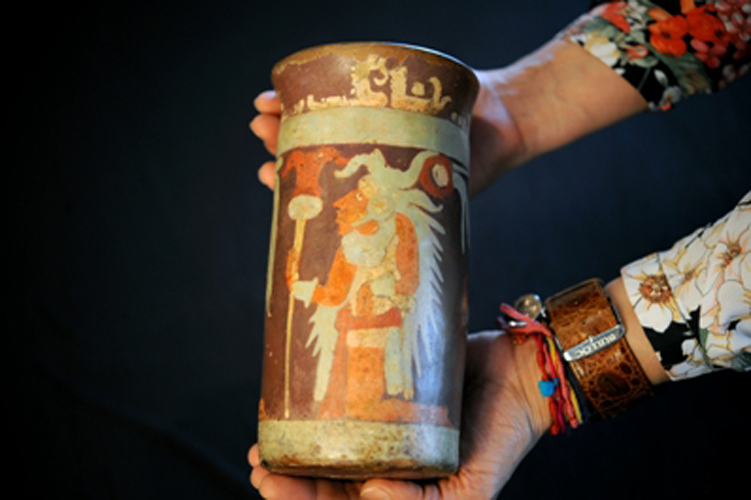Federal prosecutions involving international theft or trafficking of cultural objects are rare. State prosecutions are novel. That is why the current case against Arnold-Peter Weiss, involving New York state law, is worth watching.
Authorities arrested Dr. Arnold-Peter C. Weiss in January for allegedly attempting to sell an ancient coin claimed to belong to Italy. A New York County District Attorney's investigator
alleges that he saw Weiss possess a Tetradrachm and observed Weiss offer the ancient silver coin for sale at the Waldorf-Astoria Hotel for $300,000. The attempted sale took place at the 40th annual New York International Numismatic Convention.
A past New York prosecution involving cultural artifacts is the famous case of
U.S. v. Frederick Schultz. That federal case resulted in the conviction a widely know Manhattan art dealer for conspiracy to violate the National Stolen Property Act (NSPA). The evidence showed that Schultz was part of a scheme that trafficked antiquities from Egypt, to England, and then to the United States. The case applied federal law, argued by federal prosecutors, who litigated in federal courts. The current case against Weiss involves state law prosecuted by a state district attorney in a state court.
Weiss is reportedly charged with violating Criminal Posession of Stolen Property (CPSP) statue, New York Penal Law 165.52. The charge is a class “C” felony punishable by up to a maximum of 15 years in prison. The statute reads: "A person is guilty of criminal possession of stolen property in the second degree when he knowingly possesses stolen property, with intent to benefit himself or a person other than an owner thereof or to impede the recovery by an owner thereof, and when the value of the property exceeds fifty thousand dollars.” A person charged with a crime is innocent unless proven guilty by proof beyond a reasonable doubt in a court of law.
 |
| Matthew Bogdanos |
Chasing Aphrodite reports that Attorney Matthew Bogdanos is the prosecutor assigned to the case. Holding a masters in classical studies from Columbia University and serving as the Marine Corps colonel who investigated the looting of the Iraq National Museum in Baghdad, Bogdanos is a person familiar with cultural heritage matters.
States are the traditional venues where property issues are handled. State courts regularly handle claims of title to property as well as stolen property prosecutions. Moreover, the states have well developed laws on the books covering property crimes, which articulate generally accepted common law property principles.
Two issues to look out for as the
Weiss case moves forward in the New York State criminal justice system include the following:
Criminal knowledgeThe New York law, like many state receiving stolen property statutes, requires the prosecution to prove that a defendant have two mental states: knowingly and intentionally. The prosecution must prove that a person knowingly was in possession of stolen property and that the defendant intended to benefit himself or another from that possession or intended to impede the recovery by the owner of the property. "Knowingly" in this context means that the person was aware that the property was stolen. "Intent" means that it was the person's conscious object to benefit himself or another or to impede recovery of the property by the true owner.
About 1/4 of the states, including New York, have laws that presume criminal knowledge in certain circumstances. New York Penal Law 165.55 states: "A person who knowingly possesses stolen property is presumed to possess it with intent to benefit himself or a person other than an owner thereof or to impede the recovery by an owner thereof." The statute also presumes criminal knowledge for certain property dealers: "[A] person in the business of buying, selling, or otherwise dealing in property who possesses stolen property is presumed to know that such property was stolen if he obtained it without having ascertained by reasonable inquiry that the person from whom he obtained it had a legal right to possess it."
The federal NSPA does not articulate the presumptions contained in New York's CPSP. However, the appeals court in
Schultz supported the application of a widely adopted principle of law known as conscious avoidance, willful ignorance, or the ostrich rule. "[A] defendant may not purposefully remain ignorant of either the facts or the law in order to avoid the consequences of the law," is the rule as explained in the instruction given to the jury in the
Schultz case. This ostrich instruction has been used in other cases too, including the Enron fraud prosecutions in 2006 against Jeffrey Skilling and Kenneth Lay. The CPSP statute takes the ostrich rule further by articulating the presumptions described above, and a jury
may--not must--infer guilty knowledge based on the applicable presumptions. Of particular interest in the
Weiss case will be whether the dealer presumption is invoked by the prosecution.
Stolen propertyThe
Schultz case spent much time resolving whether Egypt's patrimony law declaring ownership over cultural objects was sufficient to give valid legal title to another such that Frederick Schultz was in knowing receipt of stolen property under U.S. law. Both the jury and the appeals court answered affirmatively. The
Schultz Doctrine essentially holds that a person may be convicted for receipt of stolen property under the NSPA when a foreign patrimony law clearly declares ownership of the cultural object and the artifact stolen was after the date of the enactment of the patrimony law. The
Schultz Doctrine does not label as stolen a cultural object that simply was unlawfully exported from a foreign nation. The foreign nation must declare clear title to the object, not just regulate its export.
New York's jury instruction regarding "stolen property " advises juries that it "is property that has been wrongfully taken, obtained, or withheld from an owner by a person who did so with the intent to deprive another of such property or to appropriate such property to himself or herself or a third person." Latching onto the federal legal holding of
Schultz, New York state prosecutors may cite the case as persuasive authority to assert that Weiss possessed "stolen property," arguing that Italy's patrimony law declares ownership of the ancient silver coin(s) allegedly possessed by Weiss. Furthermore, the state prosecutors will likely also rely on New York Penal Law 165.60, which says that it is no defense to a criminal possession of stolen property case that "the larceny [or theft, which is the term used in jury instructions] of the property did not occur in this state."
Italy's
patrimony law, adopted in 1909 and renewed in 2004, is known as the Code of the Cultural and Landscape Heritage. Articles 10, 91, and other provisions arguably define and declare ownership of cultural artifacts. Article 91 states:
"The things indicated in article 10, found underground or in sea beds by whomsoever and howsoever, shall belong to the State and, depending on whether they be immovable or movable, shall become part of government property or of its inalienable assets, pursuant to articles 822 and 826 of the civil code."
Weiss' next court date is July 3, 2012.
Reference:
http://www.nycourts.gov/cji/2-PenalLaw/165/165-45(3).pdf
CONTACT:
www.culturalheritagelawyer.com












-page-001.jpg)








